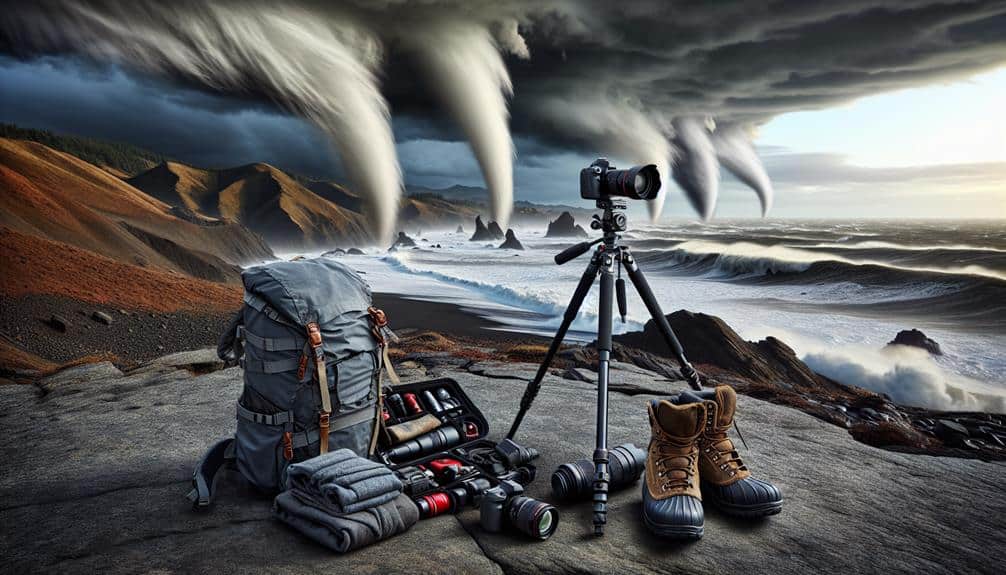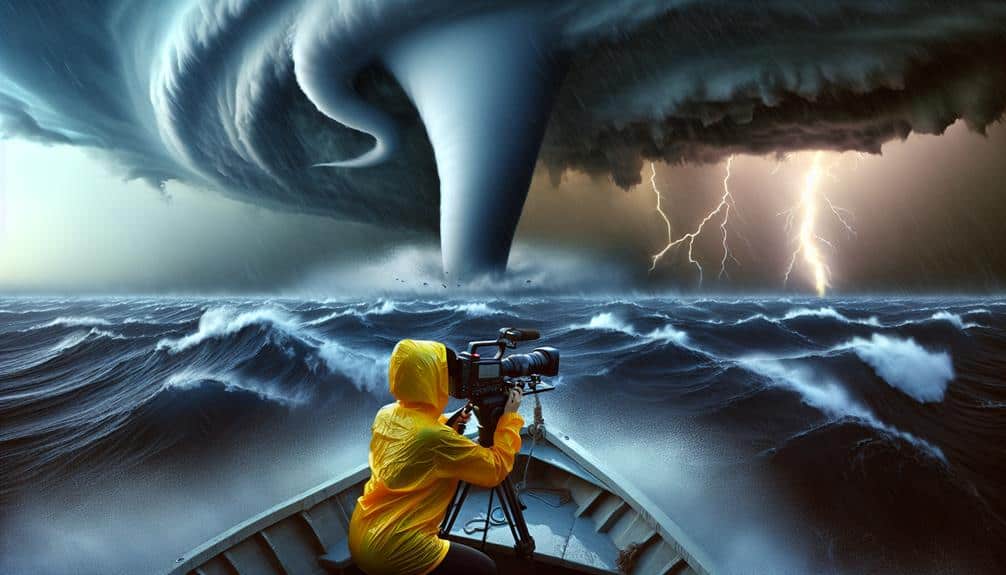When pursuing waterspouts, we should closely observe weather alerts, interpreting wind patterns and storm structures through radar and satellite imagery. Crucial gear includes waterproof clothing, non-slip footwear, and reliable communication devices. We must maintain a safe distance by evaluating the waterspout's strength and movement, keeping several miles buffer zone. Emergency preparedness is crucial, with clear evacuation plans, emergency supplies, and practiced procedures. Ensuring our safety allows us to observe these phenomena without unnecessary risks. Maintaining a balance between curiosity and caution will uncover more of what lies ahead.
Key Points
- Monitor weather alerts and radar imagery closely to track potential waterspouts.
- Wear protective waterproof clothing and sturdy, non-slip footwear.
- Maintain a safe distance of several miles to avoid direct encounters.
- Carry reliable communication devices and fully stocked emergency kits.
Understanding Waterspouts
Waterspouts are typically defined as intense columns of swirling air and water mist that form over bodies of water. When we look at the formation process, we see two distinct types: fair-weather waterspouts and tornadic waterspouts. The fair-weather variety forms under developing cumulus clouds, often in calm conditions. Conversely, tornadic waterspouts stem from severe thunderstorms and share characteristics with land-based tornadoes.
Identifying characteristics of waterspouts include their slender, funnel-like appearance and rapid rotation. We often observe a dark, turbulent base at the water's surface, which signifies the waterspout's contact point. Fair-weather waterspouts generally exhibit a smaller, more translucent funnel, while tornadic ones appear darker and more opaque, indicating greater intensity.
Understanding these features helps us appreciate the dynamic nature of waterspouts. They form quickly and can last from a few minutes to over half an hour. As we chase these phenomena, recognizing the subtle differences in their structure and behavior allows us to anticipate their movements and prepare accordingly.
This precise knowledge enables us to make informed decisions, maximizing our safety and freedom while observing these enthralling natural events.
Monitoring Weather Conditions
To effectively pursue waterspouts, we must attentively monitor weather conditions to anticipate their formation and movement. Our first step involves examining weather alerts issued by meteorological agencies. These alerts provide real-time updates on atmospheric conditions conducive to waterspout formation. By staying informed, we can align our chase strategy with the most likely locations and times for waterspout activity.
Analyzing wind patterns is essential. Waterspouts typically form under specific wind conditions, often associated with converging airflows and localized wind shear. We should use advanced weather models and tools to track these wind patterns accurately. Observing shifts in wind direction and speed helps us predict where waterspouts might develop and move, allowing us to position ourselves effectively without unnecessary risk.
Furthermore, we need to interpret radar and satellite imagery with accuracy. These tools enable us to visualize storm structures and identify potential waterspout-producing systems. By integrating data from multiple sources, including weather alerts and wind pattern analysis, we enhance our ability to make well-informed decisions.
In essence, our freedom to chase waterspouts safely hinges on our ability to monitor weather conditions with scientific thoroughness and analytical insight. This ensures we remain prepared and responsive to the dynamic nature of waterspouts.
Essential Safety Gear
Equipping ourselves with essential safety gear is vital to safeguard our well-being while chasing waterspouts. Protective clothing serves as our first line of defense against the elements. We should wear waterproof, wind-resistant jackets and pants to shield us from harsh rain and wind. Additionally, sturdy, non-slip footwear guarantees stable footing on wet surfaces. These precautions reduce our risk of injury and hypothermia in unpredictable weather.
Communication devices are equally important in ensuring our safety. Reliable radios and fully charged mobile phones keep us connected with each other and emergency services. Satellite phones are particularly valuable in remote areas where cellular signals may be weak or nonexistent. By maintaining communication, we can promptly relay changes in weather conditions and coordinate our movements to avoid danger.
Our preparedness doesn't stop there. We should also carry first aid kits to address minor injuries immediately. High-visibility vests improve our visibility in low-light conditions, reducing the probability of accidents. Personal flotation devices are indispensable when near water, providing buoyancy if we unexpectedly enter the water.
Maintaining Safe Distance
Maintaining a safe distance from waterspouts is crucial to minimize the risk of being caught in their powerful winds and turbulent waters. As we chase these captivating phenomena, our primary goal should be proper navigation and thorough risk assessment. By doing so, we make sure that we can observe waterspouts without compromising our safety.
First, we must gauge the waterspout's movement and strength. This involves monitoring weather data and using navigational tools to chart a safe course. Proper navigation is crucial; it allows us to stay clear of the waterspout's path and avoid sudden changes in direction that could bring us dangerously close.
Risk assessment is another key factor. We need to evaluate the potential hazards based on the waterspout's size, speed, and proximity. By maintaining a buffer zone of at least several miles, we reduce the likelihood of encountering severe conditions. This buffer gives us ample time to react should the waterspout change direction or intensity.
Emergency Preparedness

In the event of an unexpected encounter with a waterspout, having a well-defined emergency preparedness plan is necessary for ensuring our safety. Our first step involves establishing clear evacuation plans. We need to identify multiple escape routes and make sure everyone is familiar with them. It's important to recognize that waterspouts can change direction rapidly, so flexibility in our plans is key.
Next, we must prepare our emergency supplies. A complete kit should include essentials like water, non-perishable food, first aid supplies, and important documents. Additionally, we should have weather-resistant clothing, a flashlight, and a battery-operated radio to stay informed about weather updates.
Moreover, communication is essential. We should establish a reliable method to stay in contact with each other, such as two-way radios or satellite phones, especially when cellular networks might be unreliable. Regularly reviewing and practicing our emergency procedures ensures that we can react swiftly and effectively.
Frequently Asked Questions
How Do Waterspouts Affect Marine Life and Ecosystems?
Waterspouts impact biodiversity and ecosystem health by disrupting marine life habitats. We observe that strong waterspouts can displace species and alter food chains, causing long-term effects on ecosystem stability and resilience.
Are There Specific Regions Where Waterspouts Are More Common?
Yes, there are waterspout hotspots where specific weather patterns make them more common. We often see them in the Florida Keys, the Great Lakes, and the Mediterranean due to favorable atmospheric and oceanic conditions.
Can Multiple Waterspouts Form Simultaneously in the Same Area?
Yes, multiple waterspouts can form simultaneously in the same area. When observing such waterspout formations, we must employ chasing precautions and safety measures to guarantee minimal risk while maintaining our freedom to explore and learn.
What Are the Differences Between Tornadic and Fair-Weather Waterspouts?
We need to understand the differences between tornadic and fair-weather waterspouts. Tornadic waterspouts form under stormy conditions with severe wind patterns, while fair-weather waterspouts arise in calm conditions. Both share similarities, but each requires different precautions.
Is It Possible to Predict the Exact Location of a Waterspout's Formation?
Imagine predicting waterspouts like finding a needle in a haystack. We can't pinpoint the exact formation location. Using chase techniques and tracking technology, we improve our odds. Safety measures guarantee our freedom to explore further.


